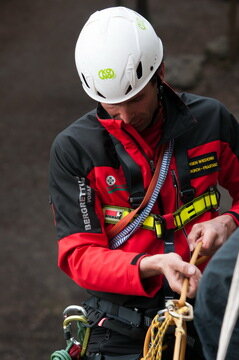Using Connector/Carabiner in Mountain Rescue Organizations - TERCOM Recommendation Nr. 1

Using Connector/Carabiner in Mountain Rescue Organizations
1. Introduction
This recommendation was raised after the failure of a central connector made of aluminum during a rescue operation in Zermatt (1998).
Central or main connectors are essential components of any organized rescue system and should provide a good margin of safety in terms of strength and construction that minimizes the ways in which a component may fail.
A number of different standards relate to connectors/carabiners including:
-
EN12275: Mountaineering Equipment - Connectors - Safety Requirements and Test Methods.
-
EN362: Personal Protective Equipment against Falls from Height - Connectors
-
NFPA 1983: Standard of Life Safety Rope and Equipment for Emergency Services.
This recommendation includes components used to attach to helicopters except where they are covered by ICAR Air Rescue Commission recommendation AIR-REC0014 HEC-HHO-Equipment.
2. Recommendation
The ICAR Terrestrial Rescue committee recommends at organized mountain rescue operations for main/central attachment points and for air rescue operations only the use of:
-
Triple action gate carabiners or
-
Connectors/carabiners with a screw gate.
-
Connectors/carabiners must conform to EN 12275 or EN 362 or NFPA 1983 US-Standard
-
Steel main or central connectors if used with air rescue.
Connectors/carabiners used in flight rescue operations as a part of the equipment of the crew or helicopter is regulated by an extra recommendation AIR-REC0014 HEC-HHO-Equipment from the ICAR Air Rescue Commission.
3. Explanatory notes
Although this recommendation relates to connectors as described in point 1, careful evaluation of equipment and components is required to ensure the best possible level of safety during organized mountain rescue activities and training.
In addition, the team using the equipment/components requires training and careful assessment of the equipment's suitability any time it is used.
The adoption of EN standards and/or NFPA 1983 standards is widely accepted across many areas of rescue. These standards offer assurance that the equipment has been manufactured and tested to agreed performance criteria including minimum breaking strengths, safe working loads and/or working load limits.
For flight operations, steel is the preferred material for organized mountain rescue activities. Steel has historically a better performance when subjected to the flight environment (steel tends to deform before failure which allows some warning; aluminum has a risk of a sudden fragile fracture type failure with little or no warning).
4. Glossary
Please look for the Glossary at the attached Files